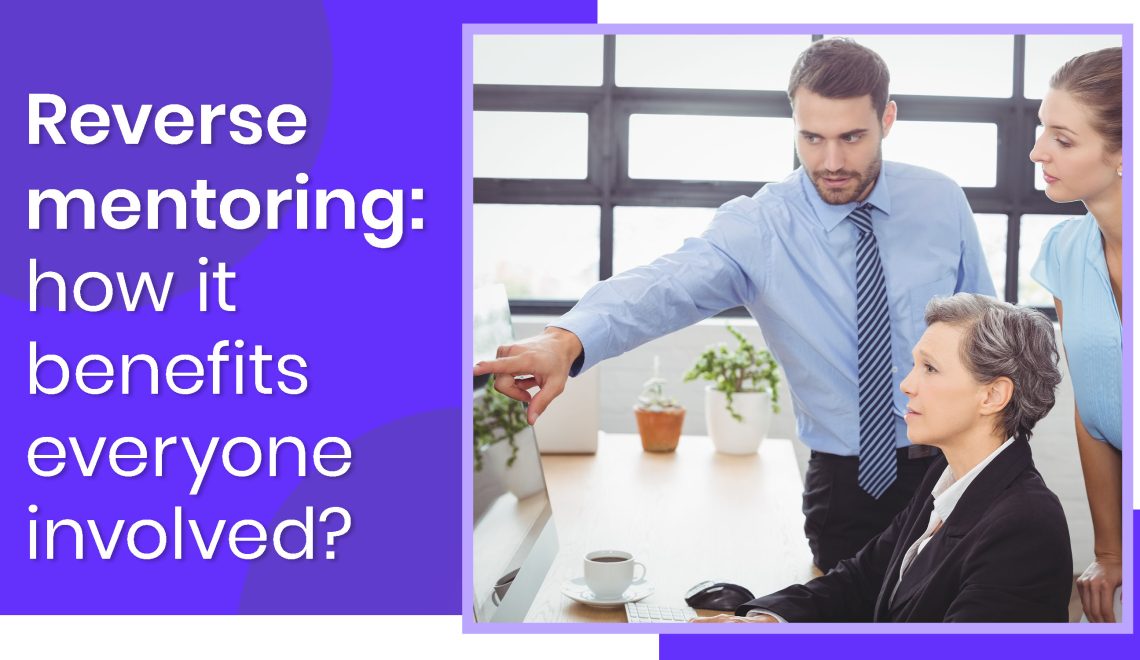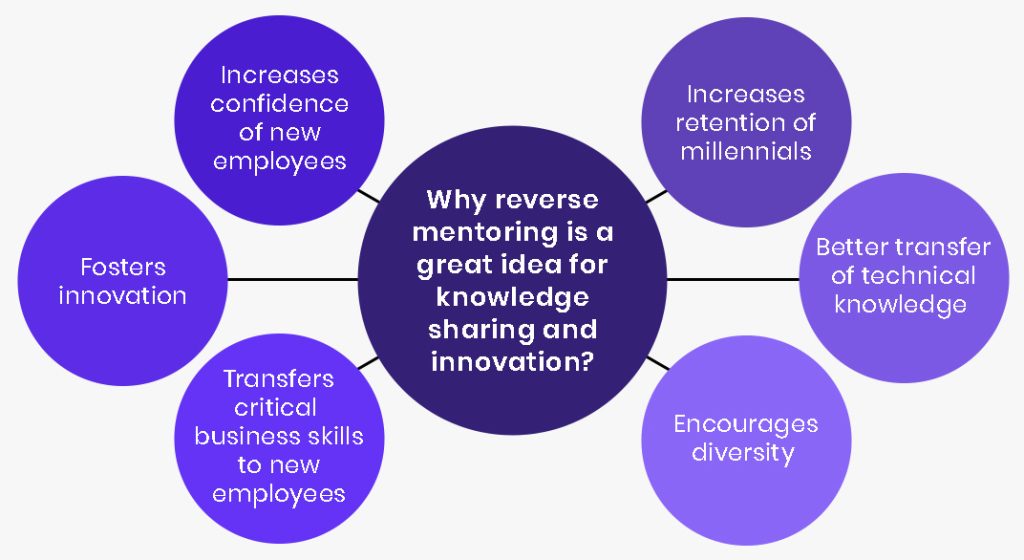
In the article, reverse mentoring is discussed from the perspective of senior and junior employees.
Mentoring allows young employees to gain valuable insights from experienced business professionals. Is there a better teacher than someone who has been there before?
However, reverse mentoring differs slightly from traditional mentoring. In this scenario, the mentoring deviates from the usual top-down approach.
An experienced employee and a newcomer engage in reverse mentoring relationships, in which they share their knowledge and enable the newcomer to present their ideas to the experienced employee. Both gain a new perspective on work and life that they might not otherwise have and thus increase their productivity. As a result of open communication and knowledge sharing, all employees benefit from this relationship.
We need to create a platform where even newcomers and youngsters can share information with senior members. A lot of times, senior executives need to use the latest technologies, but in reality, they may not have the time to learn the technologies. The younger employees have more exposure to the latest technologies and digital platforms. Reverse mentoring is one means of making this knowledge accessible to the entire organization.
It is a win-win situation where senior executives are exposed to the technical knowledge of the junior employees, and the junior employees understand more about the organization and business during the interaction. In many ways, younger employees may bring a fresh perspective that can be beneficial to the organization. They may have new ideas for how to improve the business or the latest technologies in the industry. The diverse perspectives they bring can be a valuable asset.
The benefits of reverse mentoring have made this strategy increasingly popular in recent years. Depending on the needs of the company, reverse mentoring can either be voluntary or mandatory. It can take place through information sharing at work, discussions, or even by participating in online forums.
Why reverse mentoring is a great idea for knowledge sharing and innovation?

Reverse mentoring is beneficial for your business for many reasons. Let’s look at the most significant ones.
Increases retention of millennials
The millennial generation has a very high attrition rate. In order to retain them, firms are seeking out new methods. Many employers are turning to reverse mentoring in order to provide millennials with the transparency and acceptance they crave. Sharing knowledge and skills makes them feel they have responsibility for a leadership executive. When millennials participate in reverse mentoring, they are more likely to be engaged than when they do not participate. In addition, they report higher levels of job satisfaction and a feeling of purpose in their work. They get a sense of accomplishment by delivering new insights to the managers. Therefore, they will be more engaged and motivated to work for a longer period of time.
Better transfer of technical knowledge
The millennial generation has experienced a technological revolution that has made them highly skilled users of technology. The rapid advancement of technology in today’s world may make it hard for senior managers to keep up with it. It can be overwhelming for most of them to learn all the technical skills of today, such as social media and cloud computing. Keeping up with the pace of modern technology could become time-consuming. The reverse mentoring program allows young employees to share their digital skills with senior executives.
Encourages diversity
Some companies do not do enough to promote unity among workers. Feeling unwelcome at work will have a huge impact on employees’ mental health, reducing productivity and increasing employee turnover. Because young employees are more susceptible to discrimination on grounds of gender, race, and ethnicity, reverse coaching could be the most effective method for promoting diversity in the workplace. Additionally, it can boost employees’ self-confidence and help them fight age discrimination.
Increases confidence of new employees
In order for organizations to thrive, everyone, especially young professionals, needs to work together and show courage to criticize errors. As junior employees are responsible for providing bottom-up guidance to senior managers, they have both the ability and authority to speak. They serve in leadership roles in reverse mentoring, allowing them to develop their confidence and leadership skills.
Fosters innovation
In many instances, junior employees are more than willing to lend a hand in changing the way business is done. By inspiring innovation and new practices in your company, they can help you achieve long-term profitability. Reverse mentors often serve as internal ambassadors to improve the performance of the entire company, for example, by shifting performance measurement from traditional to digital platforms. They can engage in social media marketing and create multimedia marketing resources that include podcasts and videos that feature customer recommendations.
Transfers critical business skills to new employees
New graduates may find it difficult to transition from the classroom to the workplace. Business and industry knowledge often compensates for the lack of technical understanding of senior employees. A new employee needs to be acquainted with your company’s cultural norms, how it operates, the appropriate language used during discussions of business concepts, and what should not be done. Skills like these are learned in the workplace and not taught in schools but are essential to survival and success at work. In reverse mentoring, new employees can learn such business skills from their managers.
Final words
Reverse mentoring has several benefits, including increased employee engagement, knowledge sharing, creativity, and innovation. Both parties gain a better understanding of each other’s needs and can identify their own strengths and development opportunities. As employees interact regularly, bonds are formed and further reinforced when they understand each other’s weaknesses and strengths. Moreover, reverse mentoring fosters diversity and inclusivity. All employees, regardless of their age or background, can feel included and benefit from each other’s experience. As long as reverse mentoring is undertaken correctly, it can promote innovation and productivity.
Think about your goals before you start your reverse mentoring program. Do you want it to be formal or informal? Are your employees also on board with this initiative? Mentoring is a two-way street, so you need to establish the right relationship. In the eyes of employees, the program must be seen as an opportunity for both parties to learn, grow, and enjoy.
Follow me on LinkedIn
FAQ
What are the 3 types of mentoring?
Distance mentoring, traditional one-on-one mentoring, and group mentoring are the 3 types of mentoring.
What are the goals of reverse mentoring?
The primary goal of reverse mentoring is to broaden employees’ perspectives and make them open-minded to learn new skills and tools.
What is the difference between mentoring and reverse mentoring?
In mentoring the flow of information happens from a senior person to a junior person while in reverse mentoring the flow of information happens from a junior person to a senior person.



